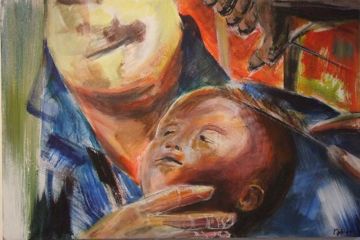How is art influenced? What role does art education play in how artists form works of art later in their career?
Recently, when I posed these questions to colleagues (both high school and college art educators), I was surprised at the responses. Some wholeheartedly believed that education has everything to do with what an artist makes later in life. Others believed that an art education is simply a starting point and doesn’t influence an artist much beyond opening them up to strategies, ways of working, and introducing key artists that may provide inspiration.
Personally, I fall somewhere in between.
When I recall my own art education and how it has influenced the work I make today, I primarily think about artists I was introduced to by my teachers, especially in high school. Works by Francis Bacon, Hans Bellmer and Käthe Kollwitz had, and still have, a profound impact on the way I approach my own subject matter. Human gesture became the foundation for much of the work I have done over the past two decades, including paintings from the “First Haircut” series (pictured above). I was literally introduced to the work of Francis Bacon after beginning a portrait series in my senior year of high school. My teacher, George Mesologites, one day remarked after a few paintings were finished that I was “using Bacon’s influence to my advantage”. Problem was, I didn’t know Francis Bacon from a hole in the wall, so I researched his work and found some of the similarities quite bizarre. But it kept me coming back to his work and led to other artists that interested me just as much as Bacon.
Years later I studied both graphic design and fine art, and was introduced to artists that enabled me to find other sources of inspiration. Artists such as Joseph Cornell, Ed and Nancy Kienholz, and Hannah Hoch made me realize how much I enjoy working with mixed-media and juxtaposition in order to convey an idea or share a memory. Even today, I often do some visual “wandering” in the studio before settling down to work- looking through tons of art books and picking up inspiration from artists I know well, along with new ones I “discover”.
Art education can influence the work an artist makes later in life only if the educational experience- those few years in school or even that single class- is transformative in some way. If it propels us, to quote Maxine Greene, to “keep arousing ourselves to begin again”, then art education has done a beautiful thing in influencing the life and work of an artist. Maybe that’s where art education can have the biggest influence? It can teach us to look beyond ourselves in order to make meaning.





Pingback: Ten for ’10 | Art21 Blog